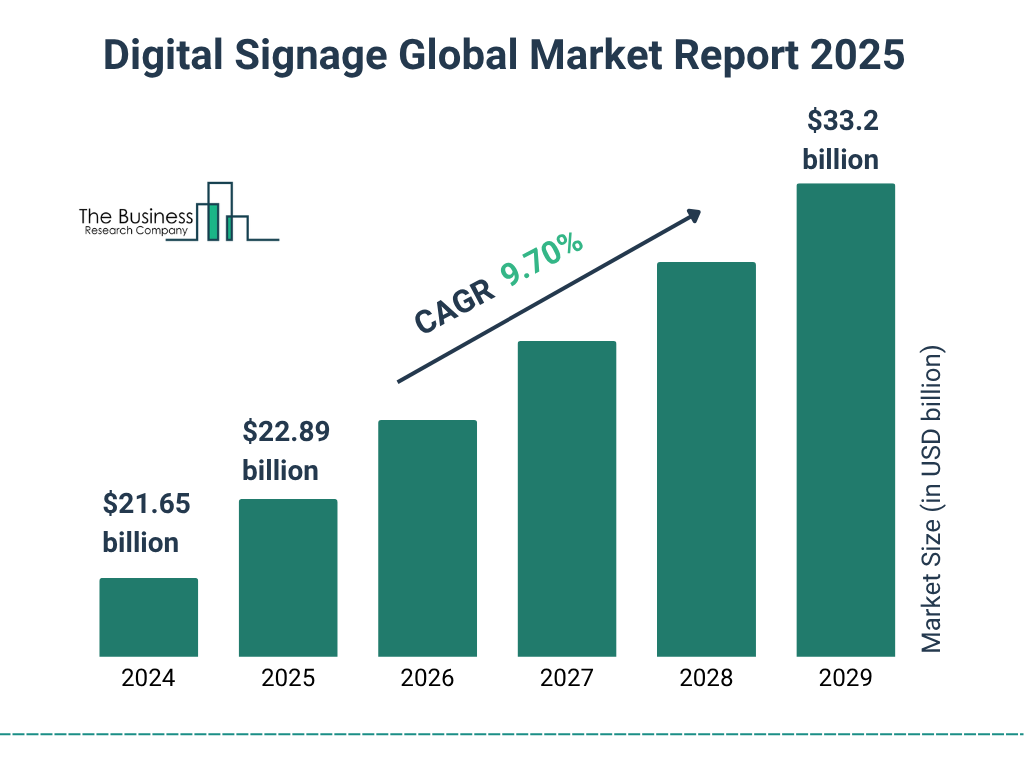5 Key Trends: How LED Display Technology Will Disrupt the Commercial Signage Market by 2026
Introduction:
The global commercial signage industry is entering a new era. Rapid innovations in LED technology—ranging from Micro LED breakthroughs to energy-saving designs—are reshaping how businesses communicate with their audiences. As we move toward 2026, these five trends will define the future of digital signage and create new opportunities for retailers, event organizers, and brand owners.
As shown in Digital Signage Global Market Report 2025, the global digital signage market is on a continuous growth trajectory. In 2024, the market size stood at $21.65 billion, and it is projected to rise to $22.89 billion in 2025. With a compound annual growth rate (CAGR) of 9.70%, the market is expected to keep expanding steadily, reaching $33.2 billion by 2029. This sustained growth reflects the strong vitality and potential of the digital signage industry, which is likely driven by technological advancements and increasing demand across various sectors such as retail, advertising, and public services, further opening up vast development space for the future.

1. Mini & Micro LED Dominate High-End Applications
By 2026, Mini and Micro LED displays are expected to capture a larger share of the premium commercial signage market. Their ultra-fine pixel pitch delivers crystal-clear images even at close viewing distances, making them ideal for flagship retail stores, luxury showrooms, and broadcast studios. Leading brands are already investing heavily in this segment, setting the benchmark for next-generation visual experiences.
2. Energy-Efficient and Solar-Powered Solutions
Sustainability is no longer optional. Manufacturers are introducing energy-saving driver ICs, low-power modules, and even solar-assisted LED billboards. These innovations reduce operational costs and meet the growing demand for eco-friendly installations, especially in regions with strict carbon-reduction targets.
3. AI-Driven Content Optimization
Artificial intelligence is transforming how content is displayed. From dynamic brightness adjustment based on ambient light to AI-powered content scheduling and predictive maintenance, intelligent systems help operators achieve higher engagement while reducing downtime and service costs.
Such America,The U.S. digital signage market size was estimated at USD 6,364.1 million in 2024 and is anticipated to grow at a CAGR of 6.6% from 2025 to 2030. This growth can be attributed to IoT, AI, and cloud technology advancements, driving personalized, interactive solutions across sectors like retail, transportation, and public services.

4. Seamless Indoor–Outdoor Integration
The line between indoor and outdoor applications is blurring. Transparent LED screens, flexible mesh displays, and ultra-thin rental panels enable creative installations across retail façades, stadiums, airports, and shopping malls. By 2026, expect hybrid spaces where indoor-grade image quality meets outdoor durability.
5. Data-Driven Advertising & Interactive Signage
Commercial signage is evolving from static advertising to interactive, data-rich experiences. Integration with sensors, 5G connectivity, and real-time analytics allows brands to target audiences with personalized messages. Interactive LED walls, touch-enabled displays, and AR-compatible solutions are becoming standard for immersive customer engagement.
Conclusion
The commercial signage market is poised for significant disruption. Businesses that embrace Mini/Micro LED, sustainable power solutions, AI-driven management, seamless indoor–outdoor integration, and interactive content will stand out in 2026 and beyond.
Contact BRIGHTEN LED !
Contact
Office : +86 0755-89341658
Mobile:+86-13924645917
Contact: Sita
Feedback













